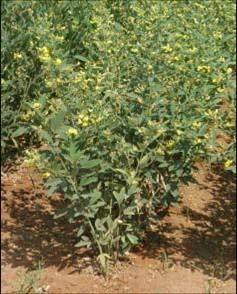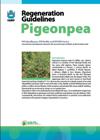Regeneration guidelines for pigeonpea
|
View regeneration guidelines in full (in PDF) Also available in the following languages: |
The information on this page was extracted from:
Upadhyaya H.D., Reddy K.N. and Sastry D.V.S.S.R. 2008. Regeneration guidelines: pigeon pea.
In: Dulloo M.E., Thormann I., Jorge M.A. and Hanson J., editors. Crop specific regeneration guidelines [CD-ROM]. CGIAR System-wide Genetic Resource Programme, Rome, Italy. 9 pp.
Before reading the regeneration details for this crop, read the general introduction that gives general guidelines to follow by clicking here.
Introduction
Pigeonpea (Cajanus cajan (L.) Millsp., syn. Cajanus indicus) is a member of the Fabaceae family and has many wild relatives. These include Cajanus scarabaeoides (L.) Thouars, C. sericeus (Benth. ex Baker) Maesen, C. acutifolius (F. Muell.) Maesen, C. albicans (Wight & Arn.) Maesen, Rhynchosia aurea, R. bracteata Benth. ex Bak and Flemingia bracteata (Roxb.) Wight (van der Maesen 1985). The pigeonpea plant is an erect annual or short-lived perennial reaching a height of 1–3 m. Because the coarse bush is deeply rooted, it has wide adaptability and grows well in semi-arid areas. It has slender, pointed trifoliate leaves and yellow or yellow and red flowers. Pods are green and pointed with some reddish mottling. Several pods are produced in clusters on an upright stem.
Pigeonpea is often cross-pollinated by bees (Megachile spp.). Cross-pollination ranges from 0–40% depending on genotype and insect pollinator populations (van der Maesen 1985). Consequently, precautions are needed during regeneration to preclude cross-pollination and preserve the genetic integrity of germplasm accessions.
Choice of environment and planting season

Pigeonpea growing in the field. |
Climatic conditions
- Pigeonpea can be grown in a wide range of climates.
- Geographical areas with low precipitation and low relative humidity during seed ripening and maturation favour crop growth.
Planting season
- Pigeonpea is a short-day species which flowers early with short days. Day length of 11–11.5 hours (Gooding 1962) and a temperature range of 22–30°C (Whiteman et al.1985) are suitable for crop growth.
Preparation for regeneration
Time to regenerate
- When seed stocks are <50 g.
- When germination drops to below 75%.
- When more than 25% of seeds are infected by one or more fungi, such as Alternaria, Aspergillus, Cladosporium, Curvularia, Fusarium, Macrophomina, Penicillium, Phoma and Rhizopus spp. (Rao and Bramel 2000).
Seed sample
- To maintain genetic integrity, use a seed sample from the original source whenever possible.
- The minimum number of plants required for regeneration is 180.
- About 23 g of seed are required to regenerate an accession.
- Treat the seed with an effective fungicide to control seed-borne fungi.
- For each accession, prepare one seed packet for planting each row.
- Label the packets with identification number and row number and arrange them according to field lay-out.
Field selection and preparation
- Choose a field that has not been under pigeonpea for the previous 2 years to reduce disease risk.
- Pigeonpea grows best on Alfisols (red soils) or Vertisols (black soils).
- Pigeonpea is susceptible to waterlogging, salinity and soil acidity. Choose fields with good drainage, low salinity and a pH between 5 and 8.5.
- Prepare the land to a fine tilth by ploughing to a depth of 15–20 cm twice, followed by harrowing two or three times.
- Make ridges 75 cm apart on a levelled field.
Method of regeneration
Pollination control
- Cross-pollination due to bees (Megachile spp.) needs to be prevented to maintain the genetic integrity of accessions.
- Cover plants with muslin bags or grow accessions in insect-proof cages to avoid cross-pollination. The latter may be a more economical way (Reddy et al. 2006).
Planting layout, density and distance
- Divide the field into plots (also known as tiers), with a 1-m walkway between them. The size of the plots can vary from 3 to 9 m wide depending on the size of the field.
- Mark rows 75 cm apart across each tier, perpendicular to the length of the field, giving rows of 3 to 9 m in length, depending on the width of the plot.
- Assign row numbers in a serpentine pattern (i.e. planting from left to right in the first row followed by right to left in the second row or vice versa).
Planting method
- Plant on top of the ridges to facilitate good drainage, easy field operations and high soil moisture availability.
- Plant seed on ridges with a 25 cm spacing between ridges.
- Dibble two or three seeds manually to 4–5 cm depth per ridge.
Labelling
- Label each accession with a tag fastened to a stake about 1 m high.
- Use strong paper for tags to withstand weathering.
Crop management
Weed management
- Apply pre-emergent herbicide to control weeds.
- Inter-cultivate 20–25 days and 45–50 days after sowing to reduce the cost of manual weeding.
- Weed manually two or three times, depending on the number of weeds.
- Weed control is critical 30–40 days after sowing.
Irrigation
- Irrigate after sowing if necessary.
- Ensure adequate soil moisture at flowering.
Fertilization
- If possible, carry out a soil test to determine fertilizer needs.
- Apply fertilizers and farmyard manure according to recommendations.
- Generally, apply a basal dose of diammonium phosphate at 100 kg/ha.
Thinning
- Thin seedlings to two plants per hill, 15 days after sowing, leaving a total of 180 plants per accession.
Common pests and diseases
Contact plant health experts to identify pests and diseases and appropriate control measures. Some of the major pests and diseases of pigeonpea are:
- Wilt (Fusarium udum): causes loss of turgidity in leaves, slight chlorosis and browning of xylem vessels from root system to the stem.
- Sterility mosaic disease, caused by virus transmitted by mites: diseased plant becomes pale green and bushy without flowers and pods.
- Pod borer (Helicoverpa armigera), pod fly (Melanagromyza obtusa) and Maruca (Maruca testulalis): feed on flowers, pods and seeds and cause huge crop losses.
Pest and disease control
- Control soil-borne diseases through solarization of soil, by covering the field with a polyethylene sheet and practising crop rotation (Rao and Bramel 2000).
- Spray an appropriate acaricide two or three times to control sterility mosaic disease.
- Application of suitable insecticides and fungicides can control pigeonpea pests and diseases.
Harvesting
- Harvest when pods are dry, which can be judged by a rattling sound when pods are shaken.
- Harvest pods from each plant separately.
- Clearly label bags/packets.
- Keep the bags of a plot (accession) together inside a labelled jute sack for drying.
- Do not harvest diseased plants.
Post-harvest management
- Thresh the pods after drying for 2–3 days (to about 12% moisture) under shade by gentle beating with wooden mallets.
- Avoid spillover and seed mixing during threshing.
- If limited numbers of pods are available, separate seeds manually.
- Clean the seeds of debris by winnowing.
- Collect equal quantities of seed from each plant in a labelled muslin cloth bag to reconstitute the accession for further drying, preferably at a lower temperature and relative humidity.
- Verify the accession identity using seed traits.
- Send a representative sample of seed for seed health and initial viability testing.
- Reject seed samples that have high infection of seed-borne fungi (>25%) or seed viability less than 75%; regenerate such accessions again in the following season.
- Dry the seeds to 8–9% moisture content for medium-term conservation.
- For long-term conservation, dry the seeds to 5–7% moisture content using forced ventilation at 15°C and 15–20% relative humidity.
- If a drying room and forced ventilation facilities are not available, dry seeds to a moisture content of 5–7% with silica gel or other suitable desiccant.
- Pack seeds in impermeable containers (plastic bottles, aluminium containers, aluminium foil packets) for conservation and distribution.
- Avoid chemical treatment of seed intended for storage.
Regeneration of wild pigeonpea
Raising seedlings
- Fill small plastic/paper cups or small pots (10 x 10 cm with a hole in the bottom) with a pasteurized mixture of 3 parts soil to 1 part farmyard manure.
- Scarify the seeds by making a small cut in the seed coat to improve water absorption and germination.
- Dress the seeds with fungicide to control seed-borne diseases.
- Put two to four seeds in each pot at about 3 cm depth.
- Water the pots every day using watering cans (Rao and Bramel 2000).
Transplanting
- Use large pots (30 x 30 cm) filled with a pasteurized mixture of soil and farmyard manure (3:1) for creeping herbs such as C. platycarpus, C. scarabaeoides and Rhyncosia species. Plant out perennial shrubs and creepers such as C. albicans, C. crassus, C. goensis, C. heynei and C. mollis in a field genebank.
- Transplant seedlings when they have three or four leaves or are 2–5 cm tall.
- Transplant the seedling to the appropriate pot or field in the evening and water it.
- Keep the new pots in shade for 2 days, keeping the soil moist.
- If transplanted to the field, plant in rows 4 m long with a spacing of at least 25 cm between plants and arrange shade for 2 days.
- Use a minimum sample size of 8 to 10 plants for each accession.
- Provide bamboo stakes to support climbers such as C. albicans, C. crassus, C. goensis, C. heynei and C. mollis (Rao and Bramel 2000).
All other procedures are the same as those for cultivated pigeonpea.
Monitoring accession identity
Compare for following traits in characterization data:
- Growth habit
- Flowering pattern
- Flower colour
- Primary seed colour
- Verify the accession identity and rogue plants that are genuine mixtures.
Documentation of information during regeneration
The following information should be collected during regeneration:
- Regeneration site name and map/GPS reference
- Name of collaborator
- Field/plot/nursery/greenhouse reference
- Accession number and population identification
- Source of seed
- Generation or previous multiplication or regeneration
- Preparation of planting materials (pre-treatments)
- Sowing date and density
- Field layout used
- Field management details (watering, fertilizer, weeding, pest and disease control, stresses recorded, others)
- Environmental conditions (altitude, precipitation, soil type, others)
- Emergence in the field or greenhouse (number of plants germinated)
- Number of plants established
- Days from sowing to flowering
- Breeding system
- Pollination control method used (method, number of plants pollinated)
- Harvest date and method
- Number of plants harvested
- Quantity of seeds harvested
- Agronomic evaluation; agro-morphological traits recorded
- Comparisons with reference materials (record any identification numbers or references of any samples taken from this regeneration plot)
- Post-harvest (describe any relevant procedures) (Rao and Bramel 2000).
References and further reading
Bioversity International, ICRISAT, ICAR. 2010. Key access and utilization descriptors for pigeonpea genetic resources. Bioversity International, Rome, Italy; International Crops Research Institute for the Semi-Arid Tropics, India; Indian Council of Agricultural Research, India. Available here.
Gooding HJ. 1962. The agronomic aspects of pigeonpeas. Field Crops Abstracts 15:1–5.
Rao NK, Bramel PJ. 2000. Manual of genebank operations and procedures. Technical Manual no. 6. ICRISAT, Patancheru, India.
Reddy KN, Upadhyaya HD, Reddy LJ, Gowda CLL. 2006. Evaluation of pollination control methods for pigeonpea (Cajanus cajan (L.) Millsp.) germplasm regeneration. International Chickpea and Pigeonpea Newsletter 13:35–38.
van der Maesen LJG. 1985. Cajanus DC and Atylosia W.& A. (Leguminosae). Agricultural University Wageningen Papers 85-4, 1985. Agricultural University, Wageningen, the Netherlands. 225 pp.
Whiteman PC, Byth DE, Wallis ES. 1985. Pigeonpea (Cajanus cajan (L.) Millsp.). In: Summerfield RJ, Roberts EH, editors. Grain Legume Crops. Collins Professional and Technical Books, London, UK. pp. 685–698.
Acknowledgement
These guidelines have been peer reviewed by Kameswara Rao, International Center for Biosaline Agriculture (ICBA), Dubai, UAE.
Comments
- No comments found






Leave your comments
Post comment as a guest